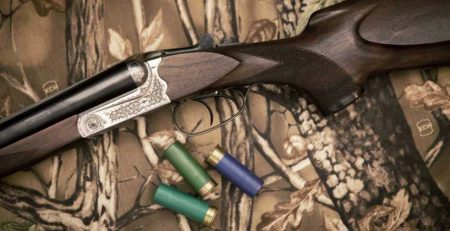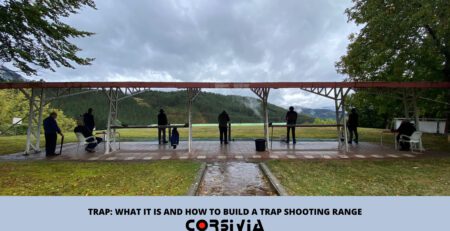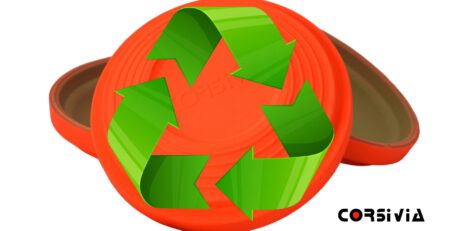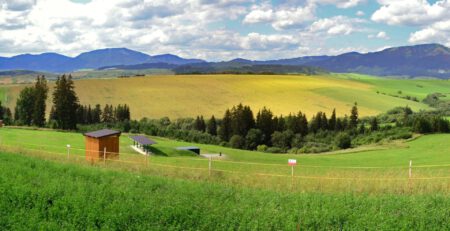SKEET: WHAT IS IT AND HOW TO BUILD A SKEET SHOOTING RANGE
A while back we posted our “Steps and Regulations for Building a Clay Target Shooting Range” blog post that explained all the steps that go into building a clay target shooting range with every guarantee.
This time we would like to go a bit further and explain everything you need to know to build your own skeet shooting range, one of the most specific disciplines in terms of its design and rules. But first, let’s take a quick look at what this Olympic discipline is all about.
Let’s go!
WHAT IS SKEET AND WHAT DOES IT INVOLVE?
Skeet is an Olympic shooting discipline, regulated by the ISSF, that was created in the 1920s by Massachusetts natives Charles Davis and William Harnden Foster, a noted grouse hunter.
Its name resulted from a vote in a US shooting magazine offering $100 to anyone who could come up with a name for this sport.
During skeet competitions, shooters must shoot from eight positions on a semicircle with a radius of 21 yards (19 m), with a “high” and “low” house at each end of the course.
Starting at the high house, shooters move through seven positions around the semicircle, firing a set combination of shots at each station. Station 8 is located between the high house and the low house, and the final shots require the shooter to break a target launched from each station.
As shooters move from one station to the other, traps launch the targets at a variety of angles designed to simulate the shots that upland hunters encounter in the field.
The targets, 11 centimetres in diameter and with a fixed trajectory and velocity, are launched in five rounds of 25 targets each, for a total of 125 targets, all of them much closer to the shooters and launched in a wider variety of patterns.
The shotgun must be a 12-gauge shotgun and is fired with 24-gram cartridges.
Let’s take a look at skeet in a bit more detail.
SPECIFICATIONS FOR BUILDING A SKEET SHOOTING RANGE
When it comes to a skeet shooting range, the main difference between a skeet and trap range is the absence of a trench and the layout of the firing line.
As we mentioned above, in skeet shooting targets are launched from two houses, one high and one low, and eight shooting stations.
HOW TO SET UP SHOOTING STATIONS
Remember these specifications when setting up the shooting stations:

- Stations 1 to 7 are arranged around a segment of a 19.2 m circle with a base chord exactly 36.8 m in length, which is 5.5 m from the centre of the circle (the target crossing point, which is marked with a stake).
- Station 1 is located at the left end of the base chord, with station 7 at the right end. Both positions must be visible from either side of the semicircle and face the centre stake.
- Stations 2 through 6 are equally spaced along the periphery of the arc, that is, the exact distance between the centre of stations 1 and 2, 2 and 3, 3 and 4, 4 and 5, 5 and 6, must be 8.13 m measured along the base chord.
- Stations 1 through 7 must be 0.9 m by 0.90 m square areas, with two sides parallel to the radius of the circle drawn to squares of the stand mark (centre of the shooting station).
- Station 8 is a rectangular area 0.9 m wide by 1.85 m long, with the long axes of the area parallel to the base chord.
- The location of each shooting stand must be accurately indicated. Shooting stations 1 to 7 must be in the centre of the side closest to the target crossing point, while shooting station number 8 must be centred midway on the base chord.
- All 8 shooting stands must be at the same level, with an elevation difference of ± 0.05 m.


HOW TO LAUNCH TARGETS FROM THE TRAP HOUSES
Every shooting station must have a trap house in a fixed position.
Targets thrown from the high house emerge 0.9 metres behind station 1 (measured along the extension of the base chord) and 3.05 m above ground level of station 1.
The targets launched from the high house must appear at a point 0.9 m behind the mark of shooting position 1 (measured along the extension of the base chord) and 3.05 m above the level of stand 1.
Targets thrown from the low house emerge 0.9 m behind station 7 (measured along the extension of the base chord and 0.75 m outside the base chord) and 1.07 m above the ground level of station 7.
Targets properly released must pass through a circular area 0.9 m in diameter located with its centre 4.6 m above the target crossing point.
In calm weather conditions, the target should carry 68 m measured from the front of the houses behind stations number 1 and 7. If the correct distance cannot be verified by measurement, the jury will decide whether the trajectory of the targets is correct.
HOW TO ESTABLISH SHOOTING BOUNDARIES
The boundary markers for shooting at stations 1 through 7 are placed at 40.23 m from the trap from which they are thrown. The boundary for shooting on station 8 is the line drawn through the station connecting station 4 with the target crossing area.
These shooting boundaries should be marked with suitable markers placed on the flight path of the target, at points 40.3 metres, 67 metres and 69 metres from both stands, to indicate the distance of a legal target.
MANDATORY SAFETY MEASURES
Like in any sporting discipline, it is necessary to establish a series of safety measures to protect both participants and spectators.
In skeet, the mandatory safety measures are:
● To protect the operator of each machine from possible injury from direct or ricocheting shots, a safety screen must be installed at the opening of each station so that the operator is not in view of the athlete when using any of the stations.
● A wire or rope barrier, parallel to the base chord, must be placed between 7 and 10 m behind station 4 to keep spectators from entering the space. In this case, the referee or members of the jury will be responsible for ensuring compliance with this rule.
● A coloured light must also be placed on the outside of both the high and low houses. These lights must be switched on immediately when the puller presses the firing button and must be switched off when the targets are thrown. The lights must be clearly visible to the referee and must be installed on the side of the stands facing the spectator area at a height of between 2.2 and 2.8 m on the high house and between 1.6 and 2.0 m on the low house.
All new skeet ranges are required to meet these specifications.
The only thing left for you to do is to get to work on your own skeet range.
However, if you still feel like you need a little help, our Coworking service is available to help you make your dream come true.
Don’t hesitate to write to us now that you have all the info you need to start building your range and ask us all the questions you have.
We’ll be delighted to help you!












